Procedural Provisions are the course of action to be followed when applying the
preferential tariff rates.
Origin procedures include the claim for the preferential tariff treatment at the
time of importation by the importer.
 Retrieved from: Outline of Rules of Origin for EPA in Japan
Retrieved from: Outline of Rules of Origin for EPA in Japan
The preferences granted under a free trade agreement are limited to products
fulfilling the origin rules of the respective agreement.
All origin legislations contain provisions on how the preferential origin of a good
can be proven and certified.
There are various ways to certify the preferential origin of goods with different
approaches for certification of the preferential origin in the ATIGA, the NAFTA,
the PAN-EURO-MED and the TPP Origin Systems.
Table of Contents
Third Party Certification System
Under the third party certification system, the exporter applies for a certificate
of origin (CO) to the CO issuing authority of the exporting country and sends the
CO to the importer.
The importer makes the claim for the preferential tariff treatment with the CO
issued by the CO issuing authority of the exporting country.
If the exporter is not the producer of the exported goods, the exporter may apply
for a CO with the information from the producer on the originating status of the goods.

Retrieved from: OUTLINE OF RULES OF ORIGIN
Self-Certification System
Under the self-certification system, the importer declares that the goods are
originating goods by submitting an origin declaration document which may be
completed by either the importer, exporter, or producer of the goods.
It is introduced under the JapanAustralia EPA, along with the third party certification
system above.
When claiming preferential tariff treatment with the selfcertification, submission of an
explanatory sheet on the originating status of the good is generally required in addition
to the origin declaration document.

Retrieved from: OUTLINE OF RULES OF ORIGIN
Approved Exporter Self-Certification System
Under the approved exporter self-certification system, the importer presents to
Customs the origin of the good by submitting an origin declaration made by an
approved exporter on an invoice or other commercial document.
The exporting country certifies their exporters as eligible to make an origin
declaration and informs the importing country (i.e. Japan) of the approved exporters.
Comparison of Origin Certification System
Comparison of Origin Certification System in the ATIGA, the NAFTA,
the PAN-EURO-MED and the TPP origin systems

Retrieved from:Comparative Study on Preferential Rules of Origin
In the PAN-EURO-MED Origin System 16 articles are dealing with the certification
of the originating status of goods. There are different kinds of proofs of origin
available for traders with different issuing procedures.
There are also exemptions possible where there is no obligation to certify the
originating status of a good.
The NAFTA origin legislation contains 4 articles regarding the certification of
origin in Section A (“Certification of Origin”) under Chapter Five: Customs
Procedures requiring that NAFTA parties establish a certificate of origin.
The NAFTA provisions on certification distinguish obligations for importers and
exporters and contain exceptions to prove the originating status by a certificate of origin.
The ATIGA Origin System has 31 rules (under Annex 8) regarding the certification
of origin of goods and other related administrative matters.
The ATIGA origin legislation contains a simple form (Form D in Annex 7) of
proofs of origin and certification requirements. It also contains exceptions to prove
the originating status by a certificate of origin.
In the TPP Origin System the certification of origin is regulated in Chapter 3,
Section B: Origin Procedures. The certification of origin must be in writing
(including electronic format) but need not follow a prescribed format as long as
it contains a set of minimum data requirements set out in Annex 3-B (Chapter 3)
to the Agreement.
In addition, there are various ways how government authorities are involved in
the issuing of certificates of origin.
The competent authorities of the Parties to the PAN-EURO MED Agreement are
directly or indirectly involved in the issuing of certificates of origin through the
authentication of certificates or the approval of exporters who can be authorized
by the customs authorities of the exporting country to issue proofs of origin
themselves without former authentication by the customs authorities
(invoice declarations irrespective of the value of the consignments).
The NAFTA certificates of origin are issued on the basis of self-certification by the
exporter/producer and the NAFTA certificates do not need to be authenticated by
a competent authority.
The government authorities in the ATIGA Origin System are directly involved in the
issuing of certificate of origin.
The ATIGA Origin System does not contain any approved exporter system.
Under the TPP Agreement the importer can make a claim for preferential treatment
based on a certification of origin completed by the exporter,
producer or importer (self-certification).
Thus there is no need for the certification of origin to be authenticated by a
government authority.
